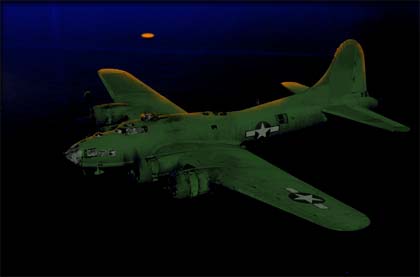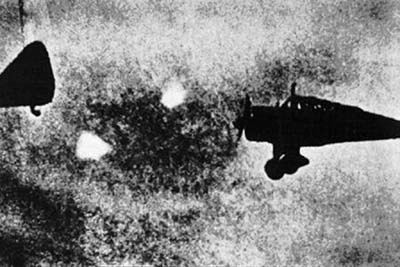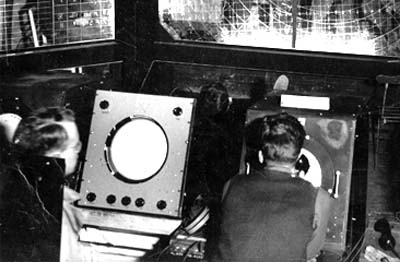pop up description layer
HOME
Cryptozoology UFO Mysteries Aviation Space & Time Dinosaurs Geology Archaeology Exploration 7 Wonders Surprising Science Troubled History Library Laboratory Attic Theater Store Index/Site Map Cyclorama
Search the Site: |
|
The Foo Fighters of World War II
December 22, 1944: The pilot of the Allied plane was nervous. He was at 10,000 feet, over enemy territory. Somewhere hidden in the black sky there was sure to be German fighter aircraft. He scanned the darkness looking for trouble. Suddenly he saw two large, orange glowing balls approaching him. His radio operator saw them too. They didn't look like enemy fighters, but neither did they look like anything he'd ever seen. The balls suddenly leveled off and started following the plane. The pilot decided to try and lose them with evasive maneuvers. He put his plane into a steep dive. The objects immediately followed. Next he tried a sharply banked turn. The objects stayed with him. For several more minutes the pilot used his best tricks to lose his pursuers and failed. When he was about to give up suddenly the objects were gone, disappearing suddenly into the night. During he whole incident not a shot was fired.
The above is a typical example of an encounter with a "foo fighter." Toward the end of World War II pilots began reporting seeing UFOs - Unidentified Flying Objects - in the shape of strange glowing balls flying around their aircraft at night. The objects seemed to maneuver with great speed and the Allies began to worry that the German's had developed a new weapon with startling capabilities. Foo Fighters and Kraut FireBalls The objects were dubbed "foo fighters" because of a popular comic strip at the time, Smoky Stover drawn by cartoonist Bill Holman. The character of Smoky was fond of saying "Where there's foo there's fire" and the objects seem to be fiery, rounded shapes. By 1944, the term "foo fighter" was used by radar operators to describe a return on the radar screen of an object that might or might not actually exist. Soon air crews were also using the term to describe the strange objects they were seeing. Occasionally, in the European War Theater, they also employed the expression "kraut fireballs." Another encounter was described by Army Air Major William D. Leet: "My B-17 crew and I were kept company by a 'foo-fighter,' a small disc, all the way from Klagenfurt Austria, to the Adriatic Sea. This occurred on a 'lone wolf' mission at night, as I recall, in December 1944..." Major Leet goes on to note that the intelligence officer that debriefed him and his crew "stated that it was a new German fighter, but could not explain why it did not fire at us, or if it was reporting our heading, altitude and airspeed, why we did not receive anti-aircraft fire." Such incidents weren't limited to Europe, either. In 1944, over the Indian Ocean, the co-pilot of a U.S. Army Air Force B-29 Superfortress reported an encounter with a peculiar UFO:
"A strange object was pacing us about 500 yards (475 m) off the starboard wing. At that distance it appeared as a spherical object, probably five or six feet in diameter, of a very bright and intense red or orange... it seemed to have a halo effect." "My gunner reported it coming in from about a 5 o'clock position (right rear) at our level. It seemed to throb or vibrate constantly. Assuming it was some kind of radio-controlled object sent to pace us, I went into evasive action, changing direction constantly, as much as 90 degrees and altitude of about 2,000 feet (600 m). It followed our every maneuver for about eight minutes, always holding a position about 500 yards (475m) out and about 2 o'clock in relation to the plane. When it left, it made an abrupt 90 degree turn, accelerating rapidly, and disappeared into the overcast." Radar Contacts Not often, but sometimes the objects would also appear on radar. On December 22nd a pilot with the 415 Night Fighter Squadron reported two "large orange glows" which climbed rapidly toward his plane as he flew over Hagenau, Germany. On the ground the radar operator also got a reading on the objects. "Upon reaching our altitude," the pilot related, the foo fighters "leveled off and stayed on my tail." He executed steep dives, banks, and other evasive maneuvers but the UFOs matched him turn after turn. "After staying with the plane for two minutes," he testified, "they peeled off and turned away, flying under perfect control, and then went out." In another incident, radar operator as Andrew V. Amrose, reported:
"I had frequently picked up a target on the radar screen that appeared to be a conventional aircraft," he said. "But... upon being tracked [it] would accelerate to a fantastic speed, which made it impossible to set a rate on and even more difficult to identify. So we referred to them as 'ghosts'... I have always been puzzled by the occurrence of these sightings I have personally made on radar." More encounters with the strange spherical UFOs were reported, but none of the objects ever seemed to take any aggressive action, so the idea that they were an advanced enemy weapon was dropped. After the war was over it was learned that German and Japanese pilots had also been seeing the same things and Axis military authorities had feared an Allied secret weapon. German Secret Weapons of World War II After the war Rudolf Lusar, who had been a major in a German army technical unit, wrote a book called German Secret Weapons of World War II . Lusar's book covered many of the known inventions like the V1 and V2 rockets, but also included a chapter on "Wonder Weapons." In the chapter Lusar claimed that the Germans had developed small automated, unconventional aircraft. One version was called the Feuerball while the other was referred to as the Kugelblitz. According the story, these craft were automatically guided and jet-propelled. These devices, according to Lusar, were supposed to use electrostatic discharges from the klystron tubes they carried to interfere with the electrical systems of the bombers' engines. Lusar's description of the Feuerball/Kugelblitz device seems very close to the "foo-fighters" observed by Allied pilots. Despite this, it seems unlikely that this is the real explanation for the UFOs/foo fighters that pilots observed. No Allied plane ever reported being attacked or disabled by a foo-fighter and it is likely that if the Germans had invented a device capable of tracking planes as well as the foo-fighters apparently did, they would have soon armed it with more effective weapon than a klystron tube. So what were these UFOs? The military decided they might be an unusual electrical or optical effect that might be related to ball lightning or St Elmo's fire. St. Elmo's fire is known to form as an electrical glow around the wing tips of planes, but is not known to form into the shape of a sphere. Ball lightning is spherical and has been observed near aircraft, but it is short-lived and is not known to fly in formation with planes.
Another possibility authorities explored was that crew might have been seeing the afterimages of bright flashes from flak explosions nearby (like the bright spot left on in your vision when a camera flash goes off in your face). This seems an unlikely explanation, however, for the many cases of foo fighters that took place when the aircraft was not receiving anti-aircraft fire. Finally they also considered the possibility that the whole thing was in the imaginations of the plane crews who were justifiably nervous under the pressure of flying dangerous war time missions. Despite all these speculations no conclusive explanation for the foo fighters has ever been found. Copyright Lee Krystek 1996-2012. All Rights Reserved. |
|
Related Links |
|
|







